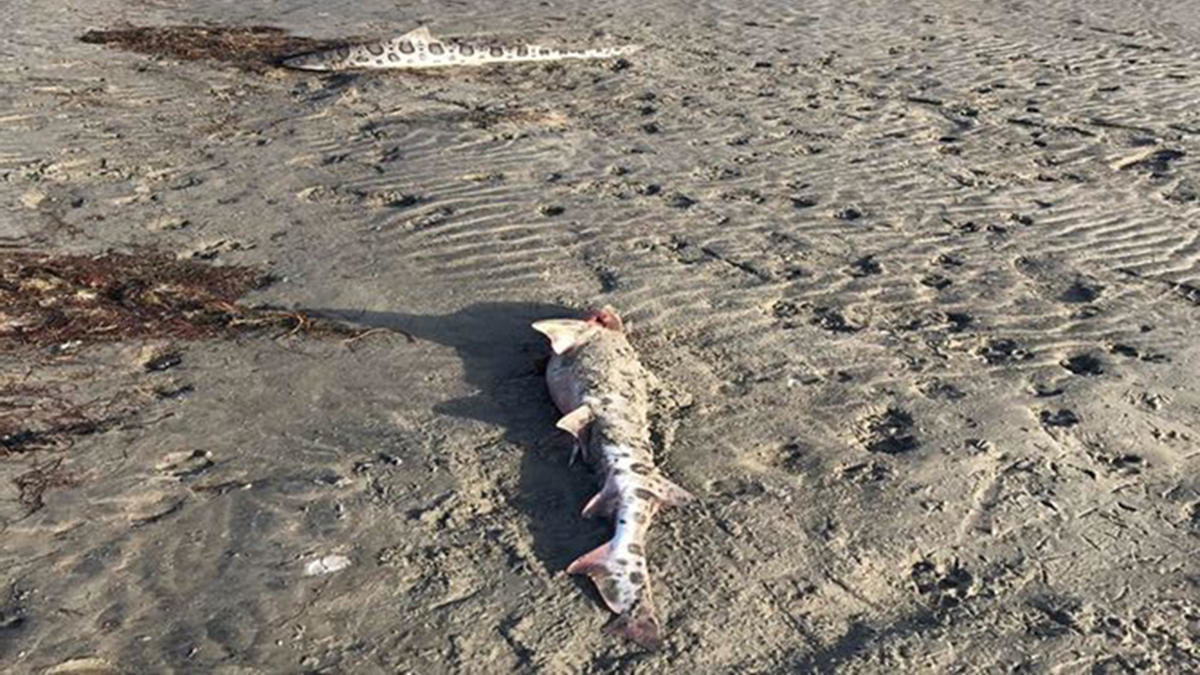
© Nate ReedDead leopard sharks
The California Department of Fish and Wildlife says determining the cause is not a priority for the state since the sharks are not threatened or endangered, however, scientists say additional research and resources are crucial since the threat is now believed to be preying on other marine life.
"This year is unusual in that there has been a large number of other species that have also been dying," said Dr. Mark Okihiro, a research scientist with the California Department of Fish and Wildlife. "This pathogen can tackle a variety of different species ... we've had a much more diverse group of fish that have been found dead in the San Francisco Bay."
At least 500 bat rays, hundreds of striped bass, 50 smooth-hound sharks and about 100 halibut died in the bay between February and July, according to Okihiro's estimates.
Tiny organism blamed for massive shark die-offSimilar shark deaths in the area date back 50 years and have gone unexplained. Okihiro, however, now believes a parasite
may be behind the mysterious die-off that has plagued the Bay Area.
"We're pretty confident at this point," Okihiro said. "It's called
Miamiensis avidus ... it's a small single celled organism. It's very similar to the common amoeba."
Okihiro regularly performs necropsies on stranded sharks found along the bay and says researchers at UC San Francisco helped him identify parasite DNA in a large number of those shark samples.
Humans who swim in the Bay or eat infected sea life are unlikely to become infected.
Parasite eats away at the brainThe deadly pathogen sneaks in through the shark's nose and slowly eats away at the brain, Okihiro says, oftentimes causing sharks to beach themselves or swim in circles. A leopard shark, exhibiting that very behavior, was spotted just outside the ballpark during a recent San Francisco Giants game and was likely in the process of dying.
O
kihiro estimates 1,000 to 2,000 leopard sharks have died in the bay so far this year, however, he concedes the death toll could actually be higher.
"The sharks you see on shore are just a small fraction of the sharks that are actually dying in the bay," he said.Sharks are not naturally buoyant. Unless they are actively swimming, their bodies sink. As a result, infected sharks that die in deep water may never actually wash up on shore.
Bay Area death toll likely more grim"I think it's almost certain that the number of sharks that have died are much higher," said Dr. Andrew Nosal, a marine biologist at UC San Diego and a top expert on leopard sharks, the main species that has washed up dead in the bay. "We have to find out what's killing these sharks."
Nosal's ongoing research centers on the migration patterns of leopard sharks. He says it is crucial the state dedicate resources towards investigating the cause of the sharks' mysterious demise.
"If we don't find out, then there's nothing we can do about it," he said.
The NBC Bay Area Investigative Unit recently joined Nosal and his colleague on their research boat off the coast of San Diego's La Jolla Cove, a known leopard shark hotspot.
"If you remove leopard sharks from the population, it is going to have a chain reaction," Nosal said. "They're eating other things and other things are eating them."
While Nosal says he is concerned that other species are now dying, he also fears the threat could spread to other ecosystems along the West Coast.
"It's isolated in San Francisco [Bay], but are we going to start seeing this up and down the coast of California?"
For now, no one knows for certain.
"I think that's what the scariest part is," Nosal said.
(Read more
here)
nothing to do with Fukushima radiation then?